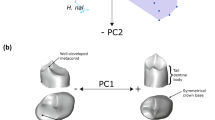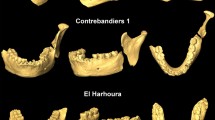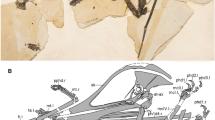Abstract
A “new” mandible of Ramapithecus punjabicus from the Siwalik deposits of West Pakistan has been discovered in the fossil primate collections in the British Museum (Natural History). R. punjabicus is the earliest hominoid which can plausibly be considered a hominid, and is of late Miocene/early Pliocene age1,2. This find is important because it provides new information on the dental, mandibular and symphyseal morphology of this interesting Tertiary primate.
This is a preview of subscription content, access via your institution
Access options
Subscribe to this journal
Receive 51 print issues and online access
$199.00 per year
only $3.90 per issue
Buy this article
- Purchase on Springer Link
- Instant access to full article PDF
Prices may be subject to local taxes which are calculated during checkout
Similar content being viewed by others
References
Simons, E. L., Proc. US Nat. Acad. Sci., 51, 528 (1964).
Pilbeam, D. R., Nature, 219, 1335 (1968).
Simons, E. L., and Pilbeam, D. R., Folia Primatol., 3, 81 (1965).
Simons, E. L., Nature, 221, 448 (1969).
Dehm, R., Bayerische Aka. Wiss., N. F. 114, (1963).
Bishop, W. W., in Background to Evolution in Africa (edit. by Bishop, W. W., and Clark, J. D.), 31 (University of Chicago Press, 1967).
Tattersall, I., Nature, 221, 451 (1969).
Author information
Authors and Affiliations
Rights and permissions
About this article
Cite this article
PILBEAM, D. Newly Recognized Mandible of Ramapithecus. Nature 222, 1093–1094 (1969). https://doi.org/10.1038/2221093a0
Received:
Issue Date:
DOI: https://doi.org/10.1038/2221093a0
This article is cited by
-
Ramapithecus wickeri Mandible from Fort Ternan, Kenya
Nature (1971)
-
“Newly” Recognized Mandible of Ramapithecus
Nature (1970)
Comments
By submitting a comment you agree to abide by our Terms and Community Guidelines. If you find something abusive or that does not comply with our terms or guidelines please flag it as inappropriate.



